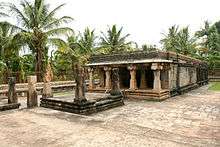History of Wayanad
The recorded history of this district exists only from the 10th century onward. In 930 AD, emperor Erayappa of Ganga Dynasty led his troops to south west of Mysore and after conquering, called it Bayalnad meaning the land of swamps. After Erayappa, his sons Rachamalla and Battunga fought each other for the new kingdom of their father’s legacy. Rachamalla was killed and Battunga became the undisputed ruler of Bayalnad. In 12th century AD, Gangas were dethroned from Bayalnad by Kadamba dynasty[1] of North Canara.[2] In 1104 AD Vishnuvardhana of Hoysala invaded Bayalnad followed by Vijayanagara dynasty in 16th century. In 1610 AD Udaiyar Raja Wadiyar of Mysore drove out Vijayanagara General and became the ruler of Bayalnad and the Nilgiris. Bayalnad is the present Wayanad.
Mysore Sultans
When Wayanad was under Hyder Ali's rule, the ghat road from Vythiri to Thamarassery invented.[3] Then the British rulers developed this route to Carter road.[4]

After Hyder Ali, his son Tipu Sultan took control over the territory.
British rule
When Wayanad was under Tipu Sultan's rule British invasion started. Tussle and turbulent times followed. The British claimed Wayanad under 1792 treaty of Srirangapatna citing it was part of Malabar. Tipu Sultan went in appeal before the Governor General. Considering his arguments, relying on the successive Karnatic rule for centuries in Wayanad and its geographical detachment from Malabar, in 1798, Governor General Lord Mornington declared by proclamation[5] that Wayanad had not been ceded to the East India Company by the treaty of 1792. Consequently, the British troops withdrew from Wayanad conceding to Tipu’s rule. In 1799, after the fall of Sultan, the British handed over Wayanad by treaty of 1799 to the Raja of Mysore. But by a supplementary treaty dated 29 December 1803 the East India Company repossessed South Wayanad and thereafter administrated by Col. Arthur Wellesley from Srirangapatna.
Etymology

Sultan Bathery was originally called as Hannaredu veethi[6] a kannada word means twelve streets. The name was changed in the 18th century, when Tipu Sultan used the Jain Temple for his armoury (Battery). And thus the town became known as Sultan's Battery, which in Portuguese Malayalam was batheria and late became bathery. But before having the name Sulthan's Bathery, It was called "Ganapathivattam" since there is a Ganapathi Temple in the midst of the town.[7]
People
One important characteristic feature of the Sulthan Bathery is the large adivasi population, consisting mainly of Paniyas, Kurumas, Ooralis, Kadans,Kattunaikkans are the different aboriginal tribes. The Kurmas is the most developed among them. They are small land owners, whereas the members of other tribes are mostly labourers. Wayanad district stands first in the case of adivasi population (about 36%) among other districts in the state. Sulthan Bathery has a large settler population. There are people from almost all parts of Kerala who migrated to this fertile land for building up their lives.One Third population of Sulthan bathery is constituted by Muslims. Christians constitute One fifth population. and rest of the population belongs to Hindus. Their hard work and sacrifice helped them to prosper. On the other hand, the last few decades have seen the complete marginalization of the indigenous people.
References
- ↑ The Kadamba kula A history of ancient and medieval Karnatak , By George M. Moraces BX furtado &sons Bombay 1931
- ↑ https://archive.org/details/kadambakula035210mbp
- ↑ Madrass District Gazetteeers, The Nilgiris. By W. Francic. Madras 1908 Pages 90-104
- ↑ Report of the Administration of Mysore 1863-64. British Parliament Library
- ↑ Proclamation No:CLXXXLL , A. Collection of treaties and engagements , By W.Logan, Calicut 1879
- ↑ wynad and it's peoples c gopalan nair
- ↑ Accounts_and_papers_of_the_House_of_Comm see page 335 wayand report